Design of surface relief grating elements for augmented reality display devices
-
摘要:
增强现实(augmented reality,AR)系统是一种将虚拟影像叠加到现实环境的显示系统,光波导是AR显示系统的核心元件,可以实现系统的微型化与轻量化。光波导耦合元件衍射效率的高低极大地影响AR显示系统的成像质量,为提高AR显示系统中耦合元件的衍射效率,该文提出了一种多层光栅叠加的波导结构,基于矢量衍射理论,采用严格耦合波分析法对光栅进行仿真分析。仿真结果显示:单层倾斜光栅的平均衍射效率在50°视场角范围内达到60%,3层光栅叠加的波导结构平均衍射效率达到85%以上,较单层光栅衍射效率提高了25%。分析结果表明,多层光栅叠加的波导结构可以实现更大的视场角与衍射效率,使AR显示系统具有更清晰的视场。
Abstract:Augmented reality (AR) system is a display system that superimposes virtual images on the real environment. Since the optical waveguide can realize miniaturization and light weight, it is the core component of the AR display system. The diffraction efficiency of the optical waveguide coupling element greatly affects the imaging quality of the AR display system. In order to improve the diffraction efficiency of the coupling element in the AR display system, a waveguide structure with multi-layer superimposed gratings was proposed. Based on the vector diffraction theory, the grating was simulated and analyzed by using the rigorous coupled wave analysis method. Simulation results show that the average diffraction efficiency of a single-layer inclined grating reaches 60% at a field of view of 50°, and the average diffraction efficiency of a waveguide structure with three layers of superimposed gratings reaches more than 85%, which is 25% higher than that of a single-layer grating. The analysis results show that the waveguide structure with multi-layer superimposed gratings can achieve a larger field of view and diffraction efficiency, so that the AR display system has a clearer viewing field.
-
引言
在高精度成像中,对给定光学系统的焦距进行测量是非常重要的。通常意义上的焦距是指某一特定波长(一般为设计波长)的焦距数值,目前主流的焦距检测设备的光源波长无法与被测光学系统完全匹配,纵向色差会对焦距的测量结果产生影响[1-4]。纵向色差是描述光学系统在不同波长下如何沿不同纵向位置聚焦,也称位置色差或轴向色差。光学系统的性能经常受色差限制而非单色像差限制,因此大多数成像镜头设计的目标都是让所有波长尽可能聚焦在同一平面[5-7],在设计波段范围内所有波长聚焦位置越接近这个相同平面,在图像中观察到的问题就越少。纵向色差可以通过测量光学系统在不同波长下的焦点位移来评估,在一些简单的纵向色差检测实验中,对焦点位置的确定是影响测量结果的一个重要因素[8-9]。为了准确检测光学系统的纵向色差,Seong等人提出一种利用马赫泽德干涉仪测量纵向色差的方法[10],首先测量单透镜和双胶合镜头在多个波长下的透射波前,然后利用波前Zernike系数确定各波长的焦点位置,再使用Sellmeir公式计算400 nm~700 nm波段的色差曲线,进而得到被测系统的纵向色差。这种方法在测量前需要对被测系统进行建模,从结果上看该方法对单透镜的色差曲线影响误差较小,而对双胶合镜头的色差曲线影响误差较大。本文针对这一问题,重点分析了不同类别光学系统的纵向色差变化规律,并尝试使用Conrady公式和复消色差特性公式表示其函数关系,同时提出一种基于菲索干涉仪测量光学系统焦点位置进而获得光学系统纵向色差函数曲线的方法。
1 原理
传统透射系统主要分为单色系统、消色差系统和复消色差系统。单色系统通常只工作在单一波长或极窄的波段范围内,大部分情况下使用同一种材料设计。由于折射率是波长的函数,光学系统的焦距也随着波长变化,所以单色系统的纵向色差是一条单调曲线。消色差系统为了消除色差,采用多种玻璃进行设计,由色差校正原理可知,对于大部分消色差系统来说,只能使2个波长聚焦在同一位置,且由于大部分消色差系统(如照相物镜)都是对“F、d、C”光进行校正,所以它们的色焦移曲线具有类似的形状。复消色差系统可以使3个波长同时聚焦在同一位置,其他波长情况下聚焦到这一平面的距离(即离焦量)相比消色差系统小很多,所以复消色差系统的像质远好于消色差系统,利用离焦量大小可以分析光学系统是否有效校正了色差,也可判断它们属于消色差系统还是复消色差系统。
不论是单色系统、消色差系统还是复消色差系统,它们的纵向色差都能用Zemax中的色焦移曲线(chromatic focal shift)表示,色焦移曲线可用于确定光学系统纵向色差的函数关系。为了验证得到的函数关系是否符合实际,使用菲索干涉仪测量光学系统不同波长的焦点位置进行验证,将采集的离散数据代入纵向色差的函数表达式求解,评估函数曲线与实际测量焦点位置数据的一致性[11-15]。
对于实际光学系统而言,衍射和像差的存在会对准确确定焦点位置造成一定困扰[16]。在光学检测中,Zernike多项式Z3的物理意义是离焦,若测量的透射波前Z3为零,则表示该位置为光学系统的焦点位置。在零离焦位置,一些微小的机械调整误差会对Z3的数值产生明显的影响,导致无法准确记录焦点位置。在离焦量较大的位置微小调整X和Y倾斜对Z3的影响则可以忽略不计。鉴于Zernike系数Z3与位置呈线性关系已通过仿真和分析得到验证[17-19],本文通过测量离焦位置波前Zernike系数Z3计算被测系统的焦点位置,原理如图1所示。通过旋转测微旋钮推动导轨上五维支架使反射球面镜沿Z轴方向移动,测量被测光学系统在焦点附近若干个离焦位置的透射波前,并记录对应位置的Z3值,将Z3与位置数据按线性方程进行拟合,再使用拟合曲线计算出Z3为零时的位置。使用相同的步骤测量并计算被测系统在其他多个波长下的焦点位置,就可以得到纵向色差。
2 模拟仿真
2.1 单色系统
以一个单一材质的单色系统为例进行分析。具体参数为F数1.5,入瞳直径20 mm,焦距30 mm,波长范围400 nm~1 000 nm,为方便数据采集分析选择400 nm作为主波长。镜头结构图和色焦移曲线如图2所示。
单色系统焦距随波长的变化主要由材料折射率引起,单调的Zernike系数-波长曲线可以使用Conrady公式[10]表示,与之相近单调的焦距-波长曲线也可使用Conrady公式表示成:
$$f = {A_f} + \frac{{{B_f}}}{\lambda } + \frac{{{C_f}}}{{{\lambda ^{3.5}}}}$$ (1) 式中:
${A_f}$ 、${B_f}$ 、${C_f}$ 分别为常数项系数和波长项系数。选取530 nm、560 nm和720 nm的焦距-波长数据代入(1)式求解系数:$$\left\{ \begin{array}{l} {\rm{29}}{\rm{.445}} = {A_f} + \dfrac{{{B_f}}}{{{\rm{530}}}} + \dfrac{{{C_f}}}{{{\rm{53}}{{\rm{0}}^{3.5}}}} \\ {\rm{29}}{\rm{.591}} = {A_f} + \dfrac{{{B_f}}}{{{\rm{560}}}} + \dfrac{{{C_f}}}{{{\rm{56}}{{\rm{0}}^{3.5}}}} \\ {\rm{30}}{\rm{.089}} = {A_f} + \dfrac{{{B_f}}}{{{\rm{720}}}} + \dfrac{{{C_f}}}{{{\rm{72}}{{\rm{0}}^{3.5}}}} \end{array} \right. $$ (2) 计算后得到单色系统的焦距-波长曲线的函数表达式为
$$\begin{split} f =& 31\;312.873\;82 - \dfrac{{786\;190.394\;4}}{\lambda } - \\ & \dfrac{{1.318\;92E + 12}}{{{\lambda ^{3.5}}}} \end{split} $$ (3) 图3(a)为单色系统焦距-波长仿真曲线与求解的Conrady公式曲线对比结果,图3(b)为曲线对比残差图。根据图3(b)显示,在400 nm~1 000 nm波段内仿真和求解曲线焦距的最大绝对误差为23.11 µm(λ=400 nm),相对误差0.08%,求解曲线基本符合仿真曲线。由于单色系统的焦距-波长曲线均为类似的形状,因此Conrady公式可用于表示单色系统的纵向色差函数关系。
2.2 消色差系统
以双高斯系统作为研究对象分析消色差系统的纵向色差。具体参数为F数2.5,焦距35 mm,波长范围400 nm~1 000 nm,主波长400 nm,镜头结构图和色焦移曲线如图4所示。
消色差系统的色焦移曲线通常带有一个拐点,选取530 nm,560 nm和630 nm的焦距-波长数据代入Conrady公式求解系数,得到双高斯系统的焦距-波长曲线的函数表达式:
$$\begin{array}{l} f = 35\;589.955\;06{\rm{ - }}\dfrac{{472\;549.724}}{\lambda } + \\ \quad {\kern 1pt} \;\;\dfrac{{8.003\;85 \times {\rm{1}}{{\rm{0}}^{{\rm{11}}}}}}{{{\lambda ^{3.5}}}} \\ \end{array} $$ (4) 图5(a)为双高斯系统焦距-波长仿真曲线与Conrady公式求解曲线的对比结果。当波长范围较大时,Conrady公式求解曲线会出现较大偏差,图5(b)是仿真曲线与Conrady公式求解曲线的残差图。从图5可以看出,在波长1 000 nm处仿真曲线和Conrady公式求解曲线的最大绝对误差为47.47 µm,相对误差为0.1349%。
为了使求解曲线与理想曲线更吻合,尝试使用复消色差特性公式求解计算。复消色差特性公式是在Conrady公式基础上拓展一个波长项后得到的。复消色差特性公式[12]为
$$f = {A_f} + \frac{{{B_f}}}{{{\lambda ^{X{\rm{1}}}}}} + \frac{{{C_f}}}{{{\lambda ^{X{\rm{2}}}}}} + {D_f}{\lambda ^{X{\rm{3}}}}$$ (5) 式中:
${A_f}$ 、${B_f}$ 、${C_f}$ 分别为常数项系数和波长项系数,X1、X2、X3为幂级数系数。通过调整幂级数系数可以将求解曲线逼近仿真曲线。幂级数系数共有3个,它们之间相互影响着曲线的特性,因此幂级数系数的选取并非是唯一的,它们存在着很多组合。本文主要在光学系统最常用的近紫外、可见光和近红外波段范围分析复消色差特性公式的幂级数系数的取值范围。最初分析复消色差特性公式时通过手动调节求解曲线的各项幂级数系数,然后与仿真曲线进行对比,这种方法效率很低,同时很难穷举确定3个幂级数系数。因此使用Matlab编写程序使得求解曲线在一定的幂级数系数范围内做循环运算,然后计算其与仿真曲线的误差大小。当求解曲线与仿真曲线偏离较大时舍弃结果,当求解曲线与仿真曲线偏离较小时则保留结果,幂级数系数范围确定的流程如图6所示。
为了能够获得合适的幂级数系数范围,根据前期手动调节幂级数系数的经验,将(5)式中幂级数系数X1范围设定为0.1~5,X2范围设定为5.1~10,X3范围设定为0.1~5,循环时每个系数的数据间隔为0.1,共进行125 000次循环测试。在循环之前,设定合理的误差对于保留曲线的幂级数系数结果来说十分重要,在400 nm~1 000 nm波段求解的复消色差特性曲线与仿真曲线的差异,可以采用绝对误差和相对误差两种方式进行评价。相对误差在求解曲线的较短波段起到限制作用,绝对误差在求解曲线较长波段起到限制作用,在这里针对双高斯系统将绝对误差设定在50 µm以内,相对误差设定在0.05%以内。
满足要求的待求解双高斯系统复消色差特性公式为
$$f = {A_f} + \frac{{{B_f}}}{{{\lambda ^{3.5}}}} + \frac{{{C_f}}}{{{\lambda ^{5.5}}}} + {D_f}{\lambda ^2}$$ (6) 将530 nm、630 nm、670 nm、720 nm处的焦距-波长数据代入(6)式求解,得到双高斯系统焦距-波长曲线的复消色差特性公式:
$$\begin{split} f = &34\;873.454\;23{\rm{ - }}\dfrac{{ - 5.305\;55 \times {\rm{1}}{{\rm{0}}^{{\rm{11}}}}}}{{{\lambda ^{3.5}}}} + \\ & \dfrac{{1.151\;65 \times {\rm{1}}{{\rm{0}}^{{\rm{17}}}}}}{{{\lambda ^{5.5}}}} + 0.000\;333\;215{\lambda ^2} \end{split} $$ (7) 图7(a)是复消色差特性公式求解曲线与仿真曲线的对比结果,在400 nm~1 000 nm波段,两者的最大绝对误差为6.1 µm(λ=400 nm),相对误差为0.02%,残差图如图7(b)所示。由图7可看出,相比Conrady公式,复消色差特性公式求解曲线几乎与仿真曲线重合,因此复消色差特性公式能用于表示消色差系统的纵向色差函数关系。
2.3 复消色差系统
为了进一步校正色差,复消色差光学系统通常需要使用特殊色散玻璃,因此复消色差系统的色焦移曲线比消色差系统更加复杂,图8为复消色差望远系统的结构图和色焦移曲线图。
复消色差系统的色焦移曲线具有2个拐点,而Conrady公式最多只能产生带1个拐点的曲线,因此只能使用复消色差特性公式(5)描述其焦距-波长曲线。图9(a)是求解复消色差特性公式曲线与仿真曲线的对比图,图9(b)是曲线残差图。根据图9(b)可知,在400 nm~1 000 nm波段内焦距的最大绝对误差为1.1 µm(λ=400 nm),相对误差小于0.01%。求解曲线与仿真曲线高度重合,此时选用的复消色差特性公式为
$$\begin{array}{l} f = 48\;226.592\;53 - \dfrac{{94\;527.933\;12}}{\lambda } + \\ \quad \quad \dfrac{{1.202\;32 \times {\rm{1}}{{\rm{0}}^{{\rm{16}}}}}}{{{\lambda ^{5.5}}}} - 0.000\;163\;547{\lambda ^2} \end{array} $$ (8) 由于复消色差特性公式能描述带2个拐点的曲线,因此可用于表示复消色差系统的纵向色差。
3 实验验证
利用波前Zernike系数与位置呈线性关系的特点,使用菲索干涉仪测量单透镜和双胶合镜头在5个波长下的若干个离焦位置波前,然后确定各波长的焦点位置,再使用实验数据求解得到被测系统在400 nm~1 000 nm波段的纵向色差曲线并进行评估。
3.1 实验测量
根据实验原理,选用5种波长的激光光源(532 nm、561 nm、632.8 nm、671 nm、721 nm)用于测量光学系统的透射波前Z3信息和焦点的位置变化,其中透射波前信息通过干涉仪测量后直接读取,焦点的位置变化通过测微旋钮的刻度读取,精度为0.005 mm,实验装置如图10所示。首先校准干涉仪的光轴与导轨,然后将球面反射镜放置在五维支架托盘上,通过旋转固定在导轨托盘上的测微旋钮推动五维支架前后移动达到获取焦点位置的目的,这样球面反射镜在前后移动测量的过程中能够与光轴尽可能保持一致,同时为减少回程误差,测量每一组透射波前时球面镜的移动方向应相同。在完成一组波长的透射波前和焦点位置记录后需要在保证光学系统不变的前提下更换激光光源。图10(b)是一个自制的光源调整台,激光器安装在该装置上能够调整X轴、Y轴位移以及倾斜,以便保证光轴不变。更换激光光源后,将剪切干涉仪放置在干涉仪的透射平面镜和被测系统之间,如图11(a)~11(e)所示,通过调整激光干涉仪的准直透镜位置保证各个波长的测试光束准直。
3.2 实验结果及数据分析
因为单色系统的色焦移曲线形状基本一致,根据实际条件选择最简单的单透镜代表单色系统进行实验。由于被测系统在不同波长测量时的焦点位置和焦深均不同,因此测量每一个波长透射波前的离焦位置及范围略有不同。将5种波长的Z3系数和位置数据进行线性拟合,结果如图12所示。
根据各离焦位置的Z3系数与位置的线性拟合计算出零离焦位置,这比直接通过干涉仪软件测量零离焦时的位置更加精确,计算结果如表1所示。使用计算的后截距数据求解Conrady公式,获得后截距-波长曲线,结果如图13(a)所示。图13(b)为实验数据和求解曲线数据的残差图,实测532 nm和721 nm处后截距与求解曲线吻合,且求解曲线与仿真曲线基本一致,说明单色系统的纵向色差可以使用Conrady公式表示。
表 1 计算得到各波长焦点位置数据Table 1. Focal position data of each wavelength波长/nm 532 561 632.8 671 721 计算的后截距/mm 8.994 9.214 9.716 9.952 10.226 按照相同的方法测量双胶合镜头的焦距位置,各波长近焦的Z3系数和离焦位置的拟合曲线如图14所示。
通过拟合曲线计算得到零离焦时的焦点位置,结果如表2所示。分别使用采集数据求解Conrady公式和复消色差特性公式纵向色差曲线,结果如图15所示。图15(a)和15(c)中求解Conrady公式曲线与实测的671 nm数据点吻合,而与721 nm处的后截距数据有较明显的偏离;图15(b)和15(d)中求解复消色差特性公式曲线能与实测的721 nm后截距数据吻合,这与仿真时的结果一致。实验及计算结果表明,消色差系统的纵向色差函数关系在400 nm~1000 nm波段需要使用复消色差特性公式表示。
表 2 计算得到的各波长焦点位置Table 2. Focal position of each wavelength波长/nm 532 561 632.8 671 721 计算的后截距/mm 10.556 10.542 10.552 10.578 10.638 4 结论
焦距检测常会因为波长不匹配而引入色差,本文分析了光学系统纵向色差的变化规律,通过软件模拟和实验验证发现在400 nm~1 000 nm波段,单色系统的纵向色差曲线可使用大家熟知的Conrady公式有效表示,而运用范围更广的消色差系统和复消色差系统的纵向色差曲线则需要使用复消色差特性公式表示,同时给出了复消色差特性公式幂级数系数范围的选定方法。本文还提出了一种基于菲索干涉仪测量光学系统纵向色差曲线的方法,通过测量离焦位置的透射波前Z3系数确定各波长的焦点位置,利用离散数据求解模型公式后获得400 nm~1 000 nm波段内光学系统的纵向色差函数曲线。本文的研究工作表明,Conrady公式和复消色差特性公式除了适用于光学系统Zernike系数的变化规律外,还同样适用于光学系统的纵向色差,这对于焦距的精确测量具有指导意义。
-
表 1 单层表面浮雕光栅参数
Table 1 Parameters of single-layer surface relief grating
参数 背景
折射率波导
折射率波导
宽度/μm光栅
厚度/μm光栅
周期/μm占空
比光栅
倾角/(°)数值 1 1.8325 5 1 0.5 0.5 30 表 2 双层表面浮雕光栅参数
Table 2 Parameters of double-layer surface relief grating
参数 光栅
厚度 /μm光栅
周期 /μm占空比 第1层光栅
倾角/(°)第2层光栅
倾角/(°)数值 1.98 0.55 0.5 10 −10 表 3 3层表面浮雕光栅参数
Table 3 Parameters of three-layer surface relief grating
参数 光栅
厚度 /μm光栅
周期 /μm占空比 第1层光栅
倾角 /(°)第2层光栅
倾角 /(°)第3层光栅
倾角 /(°)数值 0.6 0.52 0.5 10 −10 10 -
[1] XIONG J, HSIANG E L, HE Z, et al. Augmented reality and virtual reality displays: emerging technologies and future perspectives[J]. Light:Science & Applications,2021,10(1):216.
[2] 杨新军, 向艳, 朱标, 等. 一种新颖的智能眼镜光学系统设计方法[J]. 应用光学,2018,39(6):815-820. YANG Xinjun, XIANG Yan, ZHU Biao, et al. Novel optical system design method for smart glasses[J]. Journal of Applied Optics,2018,39(6):815-820.
[3] LEE Y H, ZHAN T, WU S T. Prospects and challenges in augmented reality displays[J]. Virtual Real. Intell. Hardw,2019,1(1):10-20. doi: 10.3724/SP.J.2096-5796.2018.0009
[4] RASMUSSEN T. Overview of high-efficiency transmission gratings for molecular spectroscopy[J]. Spectroscopy,2014,29(4):32-39.
[5] CHENG D, WANG Y, XU C, et al. Design of an ultra-thin near-eye display with geometrical waveguide and freeform optics[J]. Optics Express,2014,22(17):20705-20719. doi: 10.1364/OE.22.020705
[6] YANG T, JIN G F, ZHU J. Automated design of freeform imaging systems[J]. Light:Science & Applications,2017,6(10):113-122.
[7] LI G, LEE D, JEONG Y, et al. Holographic display for see-through augmented reality using mirror-lens holographic optical element[J]. Optics Letters,2016,41(11):2486-2489. doi: 10.1364/OL.41.002486
[8] FROMMER A. 11-3: Invited paper: lumus optical technology for AR[J]. Sid Symposium Digest of Technical Papers, 2017, 48(1): 134-135.
[9] ATAC R, EDEL M. Binocular scorpion helmet-mounted display[J]. SPIE,2011,8041:108-112.
[10] MUKAWA H, AKUTSU K, MATSUMURA I, et al. A full-color eyewear display using planar waveguides with reflection volume holograms[J]. Journal of The Society for Information Display,2009,17(3):185-193. doi: 10.1889/JSID17.3.185
[11] 曾飞, 张新, 张建萍, 等. 基于棱镜-光栅结构的全息波导头盔显示系统设计[J]. 光学学报,2013,33(9):114-119. ZENG Fei, ZHANG Xin, ZHANG Jianping, et al. Holographic waveguide head-mounted display system design based on prisms-grating structure[J]. Acta Optica Sinica,2013,33(9):114-119.
[12] 姜玉婷, 张毅, 胡跃强, 等. 增强现实近眼显示设备中光波导元件的研究进展[J]. 光学精密工程,2021,29(1):28-44. doi: 10.37188/OPE.20212901.0028 JIANG Yuting, ZHANG Yi, HU Yueqiang, et al. Research progress of optical waveguide components in augmented reality near-eye display devices[J]. Optics and Precision Engineering,2021,29(1):28-44. doi: 10.37188/OPE.20212901.0028
[13] 曹润苍. 基于RCWA方法的表面浮雕光栅波导AR系统设计与优化[D]. 杭州: 浙江大学, 2021. CAO Runcang. Design and optimization of surface relief grating waveguide AR system based on RCWA method[D]. Hangzhou: Zhejiang University, 2021.
[14] 杨培培. 基于飞秒激光微纳光刻技术的AR衍射光波导研究[D]. 杭州: 浙江师范大学, 2021. YANG Peipei. Research on AR diffracted light waveguide based on femtosecond laser micro-nanolithography technology[D]. Hangzhou: Zhejiang Normal University, 2021.
[15] CHENG D, WANG Q, LIU Y, et al. Design and manufacture AR head-mounted displays: a review and out-look[J]. Light:Advanced Manufacturing,2021,2(3):350-369.
[16] MOHARAM M G, GAYLOR T K. Rigorous coupled-wave analysis of planar-grating diffraction[J]. JOSA,1981,71(7):811-818. doi: 10.1364/JOSA.71.000811
[17] 陈为, 廖胜. 严格耦合波法计算闪耀光栅衍射效率[J]. 应用光学,2009,30(5):734-738. doi: 10.3969/j.issn.1002-2082.2009.05.004 CHEN Wei, LIAO Sheng. Rigorous coupled-wave method for diffraction efficiency calculation of blazed gratings[J]. Journal of Applied Optics,2009,30(5):734-738. doi: 10.3969/j.issn.1002-2082.2009.05.004
[18] 石在耀. 应用于全息波导的新型耦合光栅衍射特性研究[D]. 南京: 东南大学, 2018. SHI Zaiyao. Study on the diffraction characteristics of novel coupling grating applied on holographic waveguide[D]. Nanjing: Southeast University, 2018:
[19] 韦信宇. 衍射式光波导近眼显示方案的设计[D]. 武汉: 华中科技大学, 2021. WEI Xinyu. Design of diffractive optical waveguide near-eye display scheme[D]. Wuhan: Huazhong University of Science and Technology, 2021.
[20] CHAO C P, MI L T, ZHANG W B, et al. Waveguide-based near-eye display with dual-channel exit pupil expander[J]. Displays,2021,67:101998-1-10. doi: 10.1016/j.displa.2021.101998




 下载:
下载:































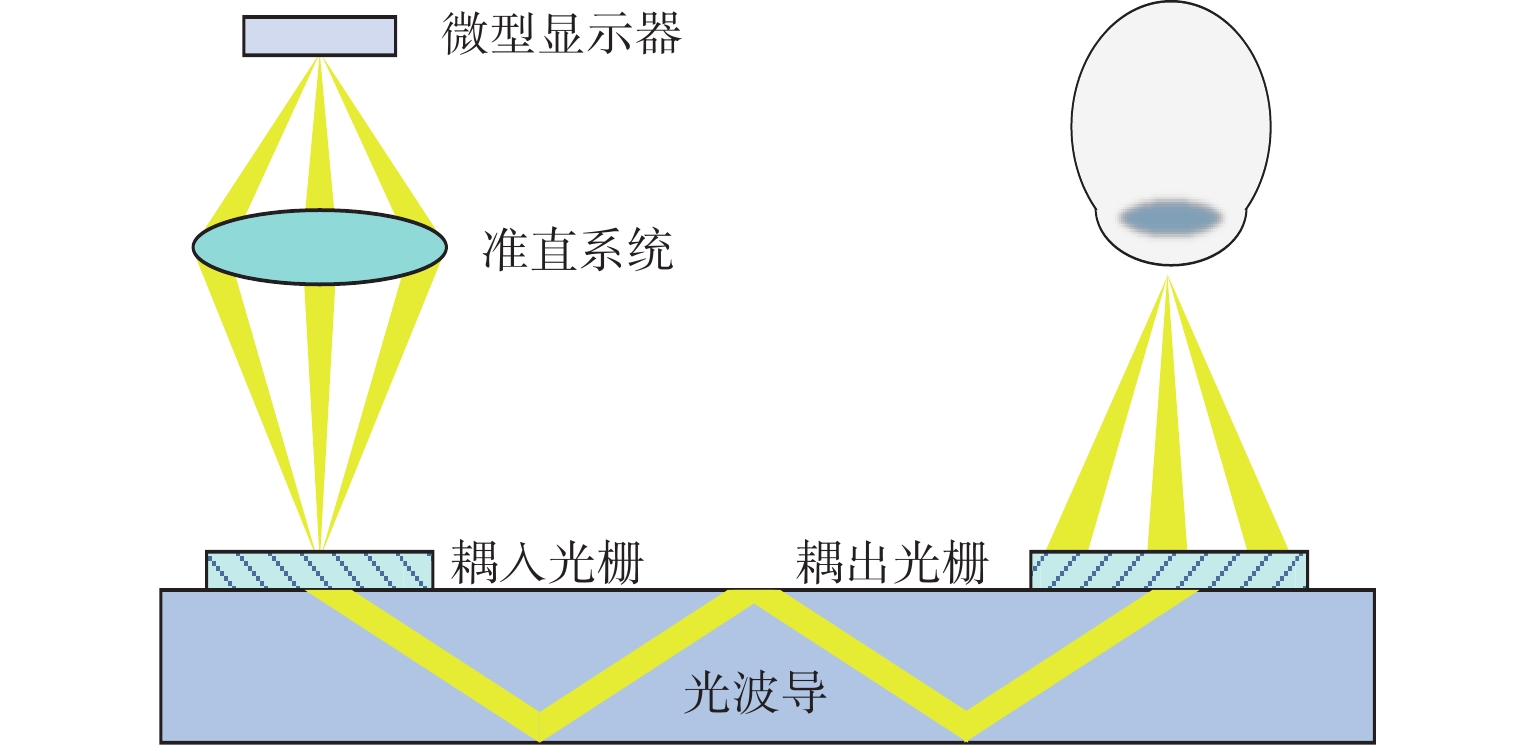
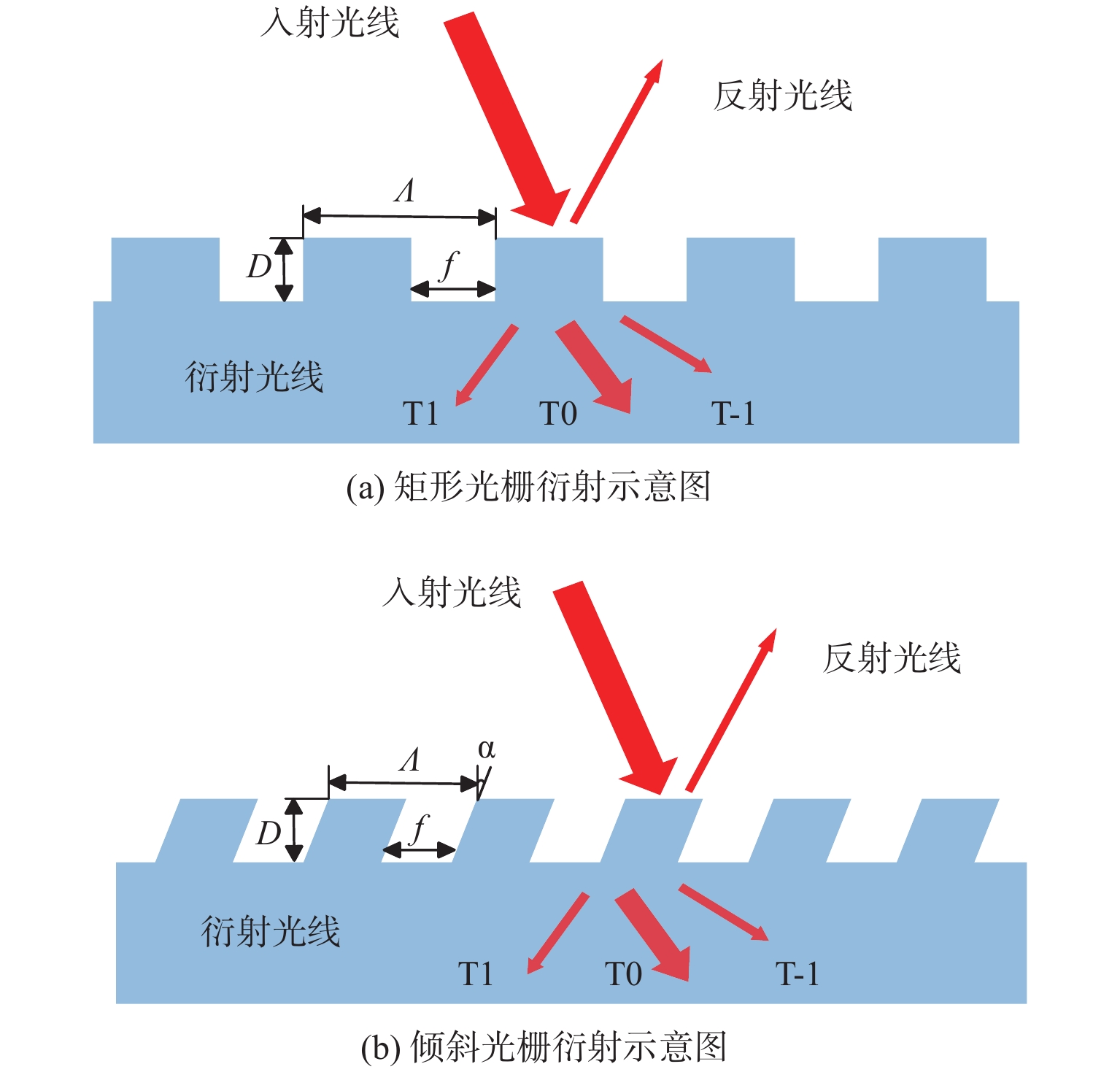

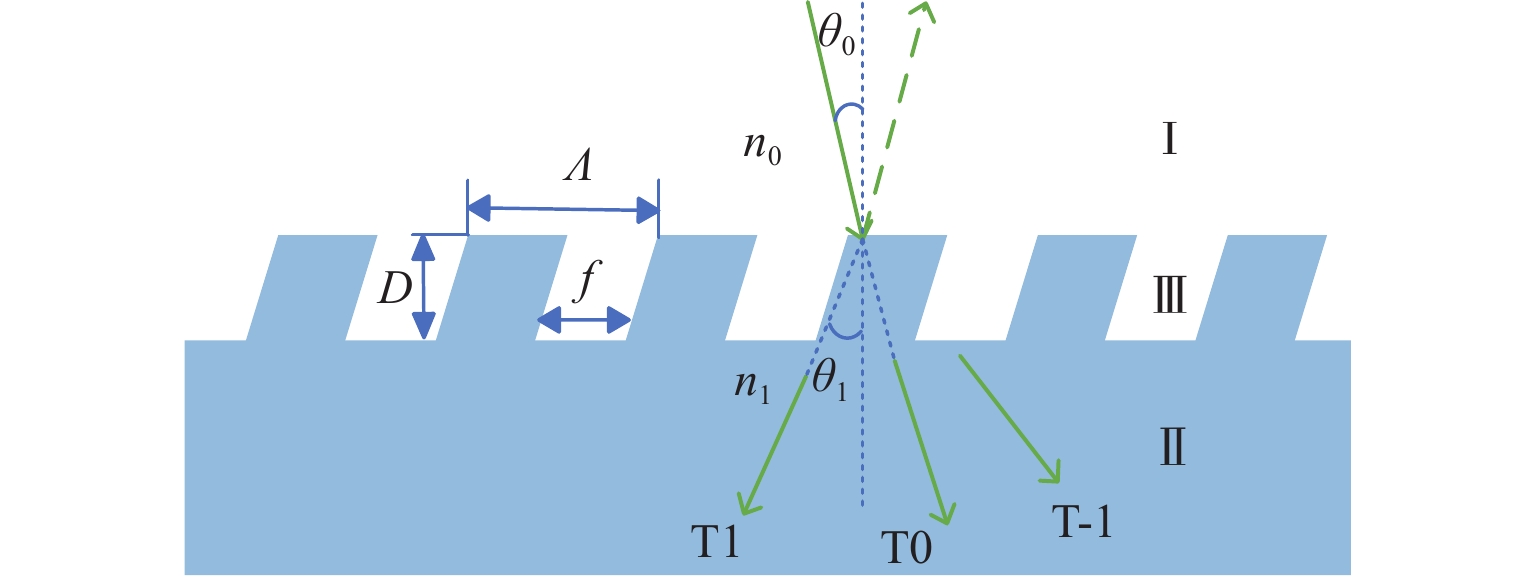
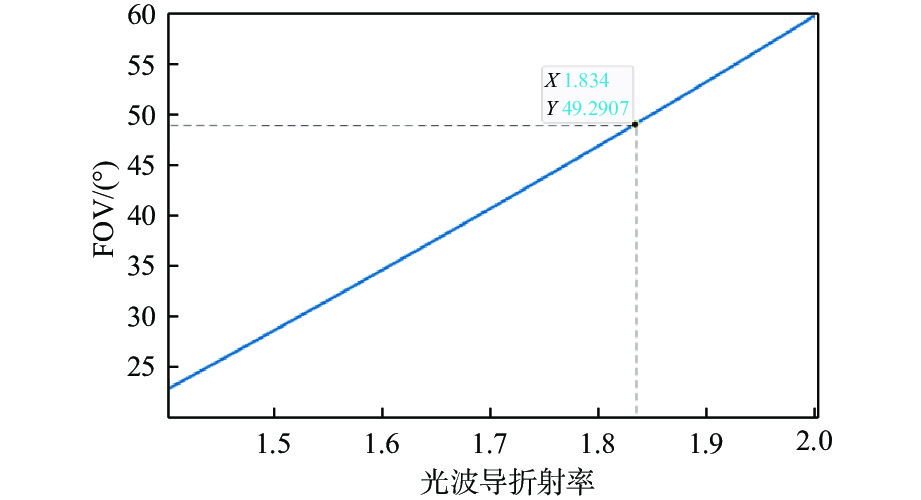

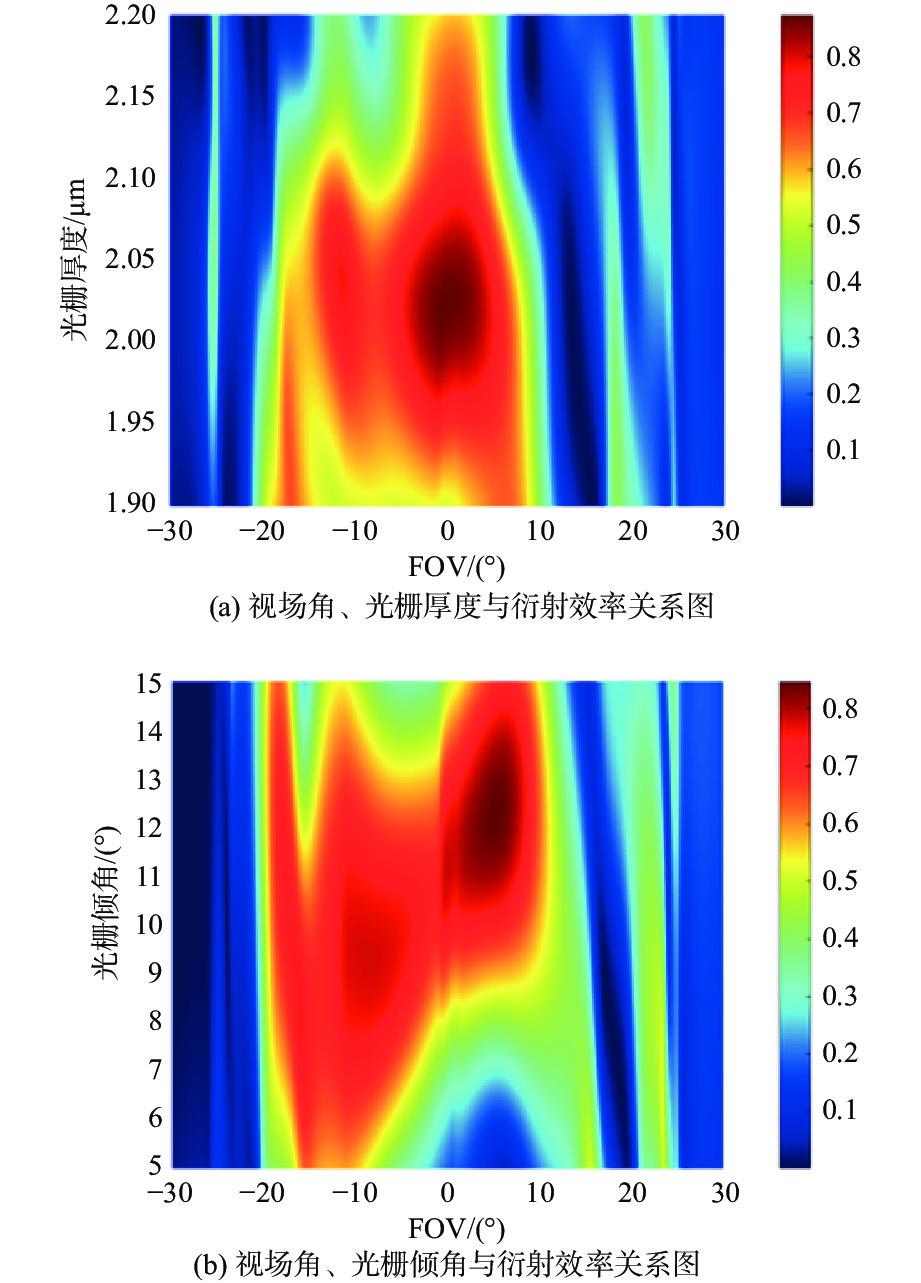
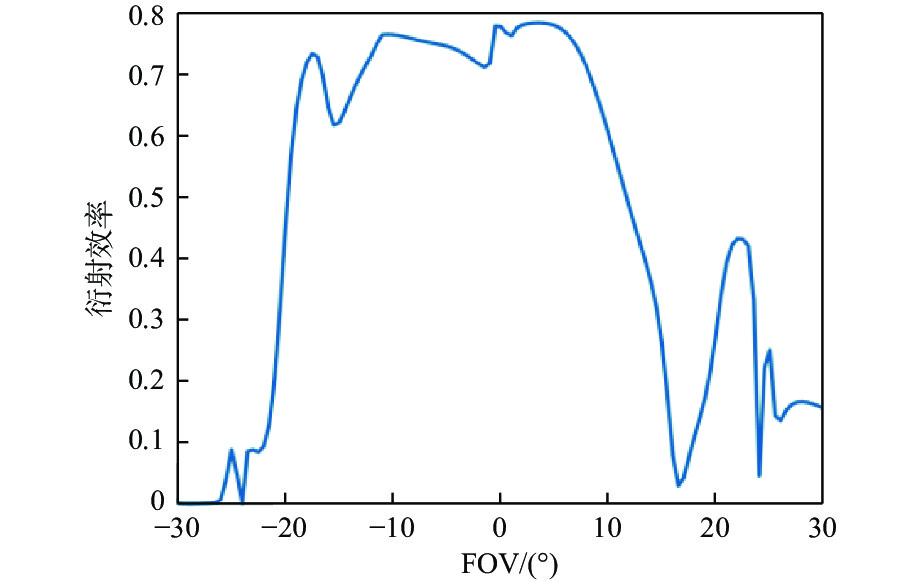

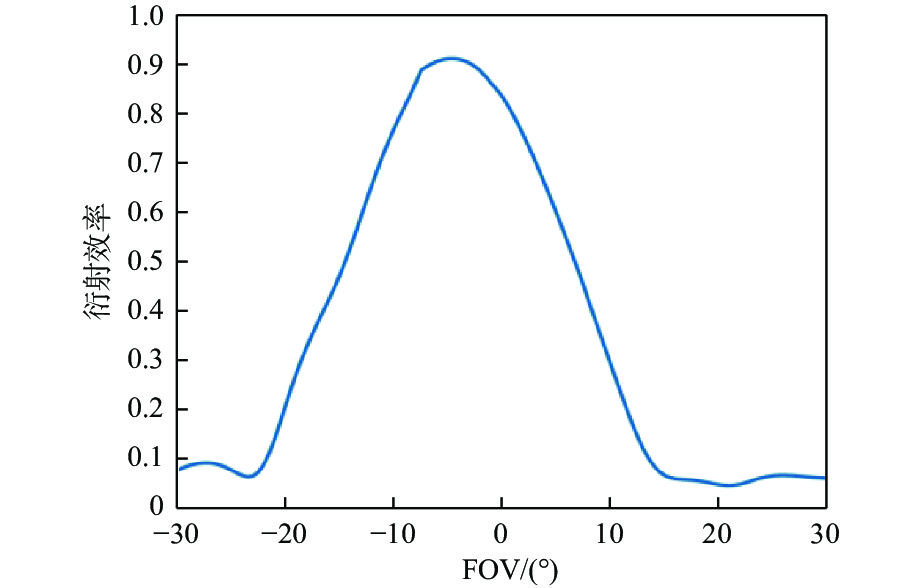
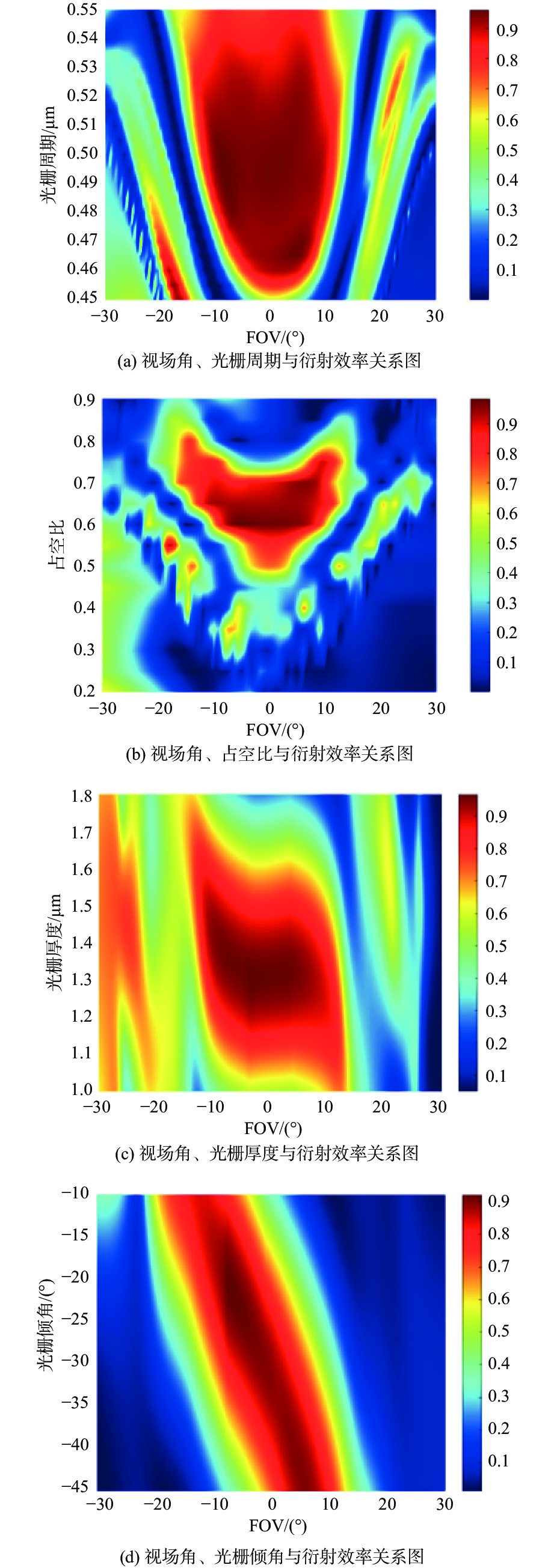
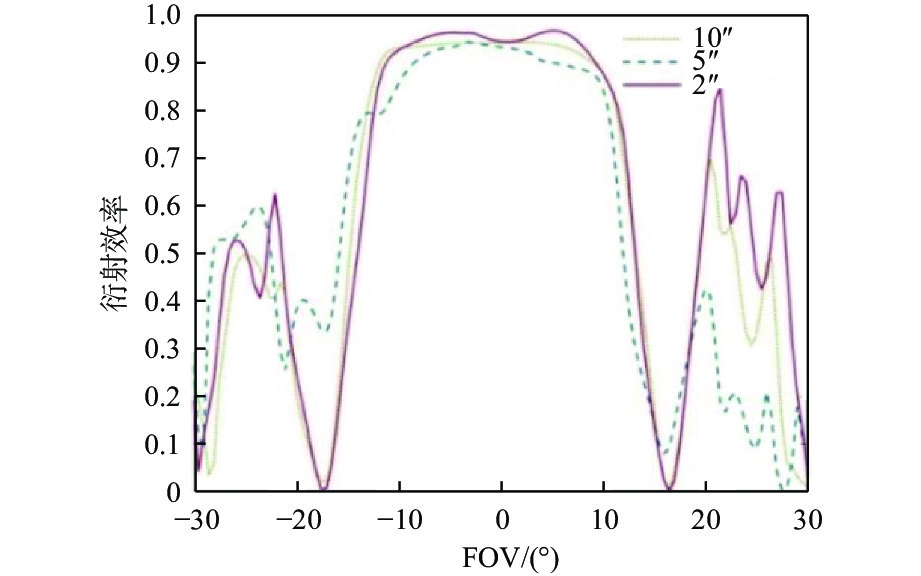
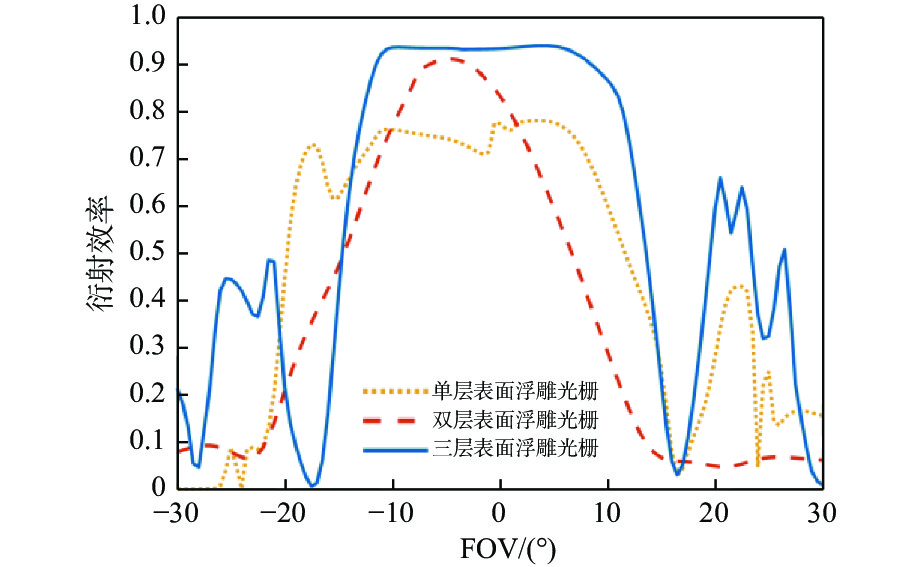

 陕公网安备 61011302001501号
陕公网安备 61011302001501号 